Queer Black Infiltration
Bones Jones
PHOTOGRAPHER
Courtney Harvier
ASSISTANTS
Jay Parel, Justin Prescott
MODELS
Jessica Zyrie, Bones Jones,
and Jay Parel
DESIGNER
Bones Jones
“Queer and trans Black
people are systematically
left out when it comes to
resources, yet we’re always
used as images on a mood
board. Our existence
infiltrates everything that
exists within this world and
our cultures. For me, it is
about the thumbprint and
the DNA that influences
these spaces without
attribution. What would
it look like for us to be
properly acknowledged?”
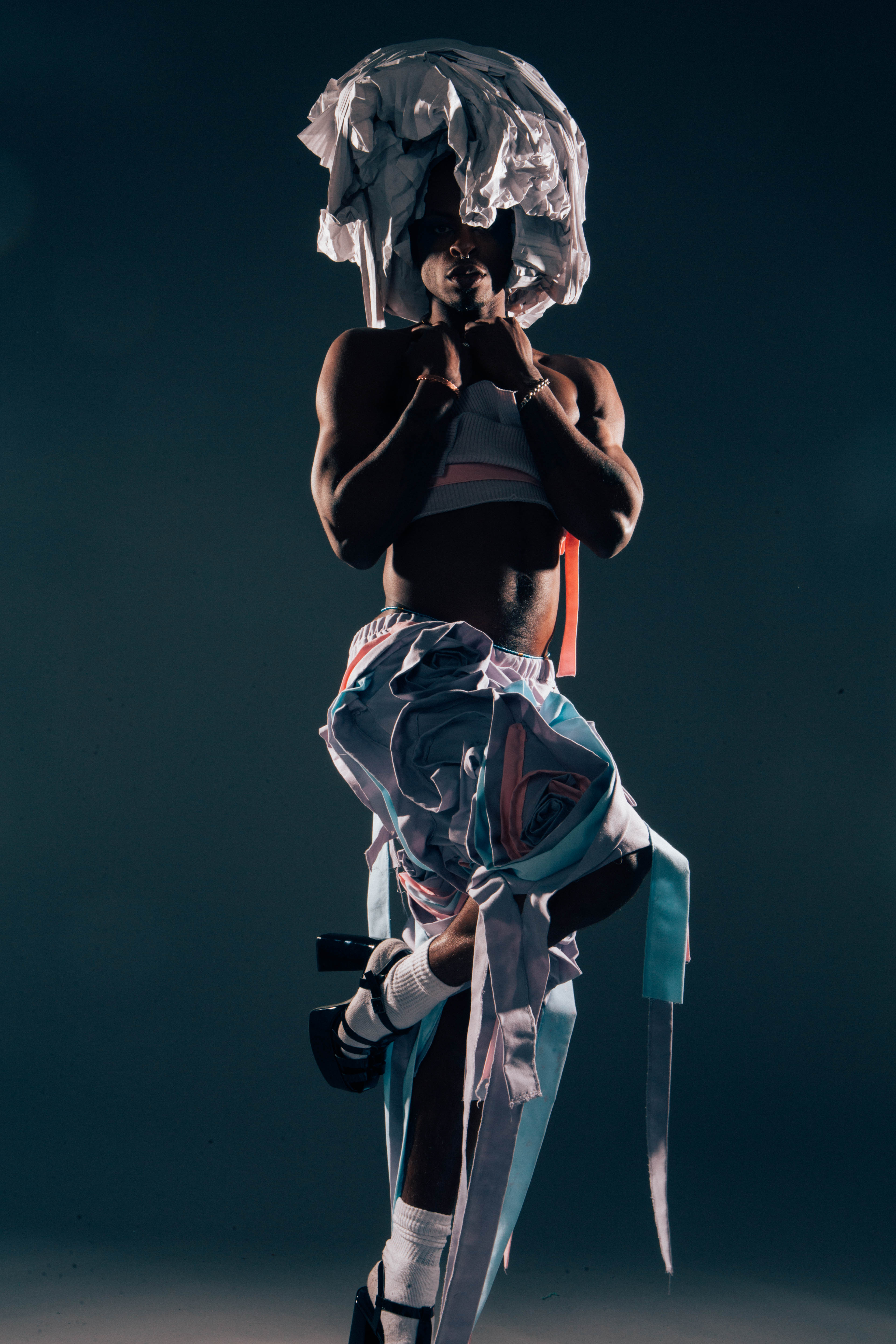

“Celebrities mimic the Black trans
underground scene without
acknowledging it. All the girls have been
looking like Kim Kardashian for the
past five years and Kim Kardashian—
no shade—got it from the trans girls.
Yes, Black women are well-shaped
and know how to dress and this, that
and the third, but there's a specific
look that comes from trans women
that’s being mimicked throughout
‘mainstream’ culture. That paradigm is
shifting because everybody want to be
Black until it’s time to be a nigga. Kim
Kardashian transitioned immediately
from Blackfishing with Kanye West to
blonde aesthetics with Pete Davidson.
While celebrities oh-so-casually shift
between appropriating Black trans
aesthetics and reclaiming whiteness, we
continue pushing the culture forward
without the resources we’re due.”
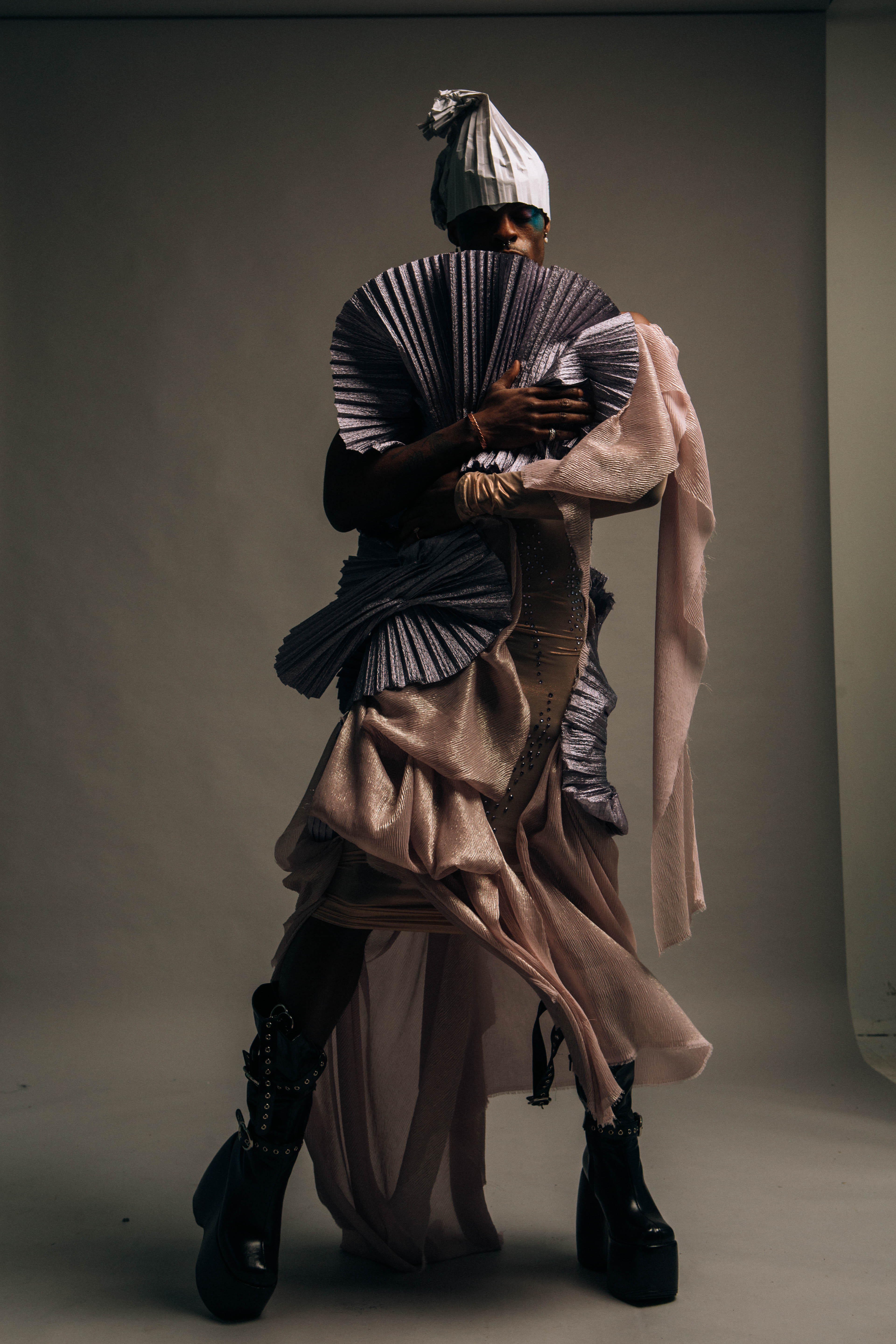
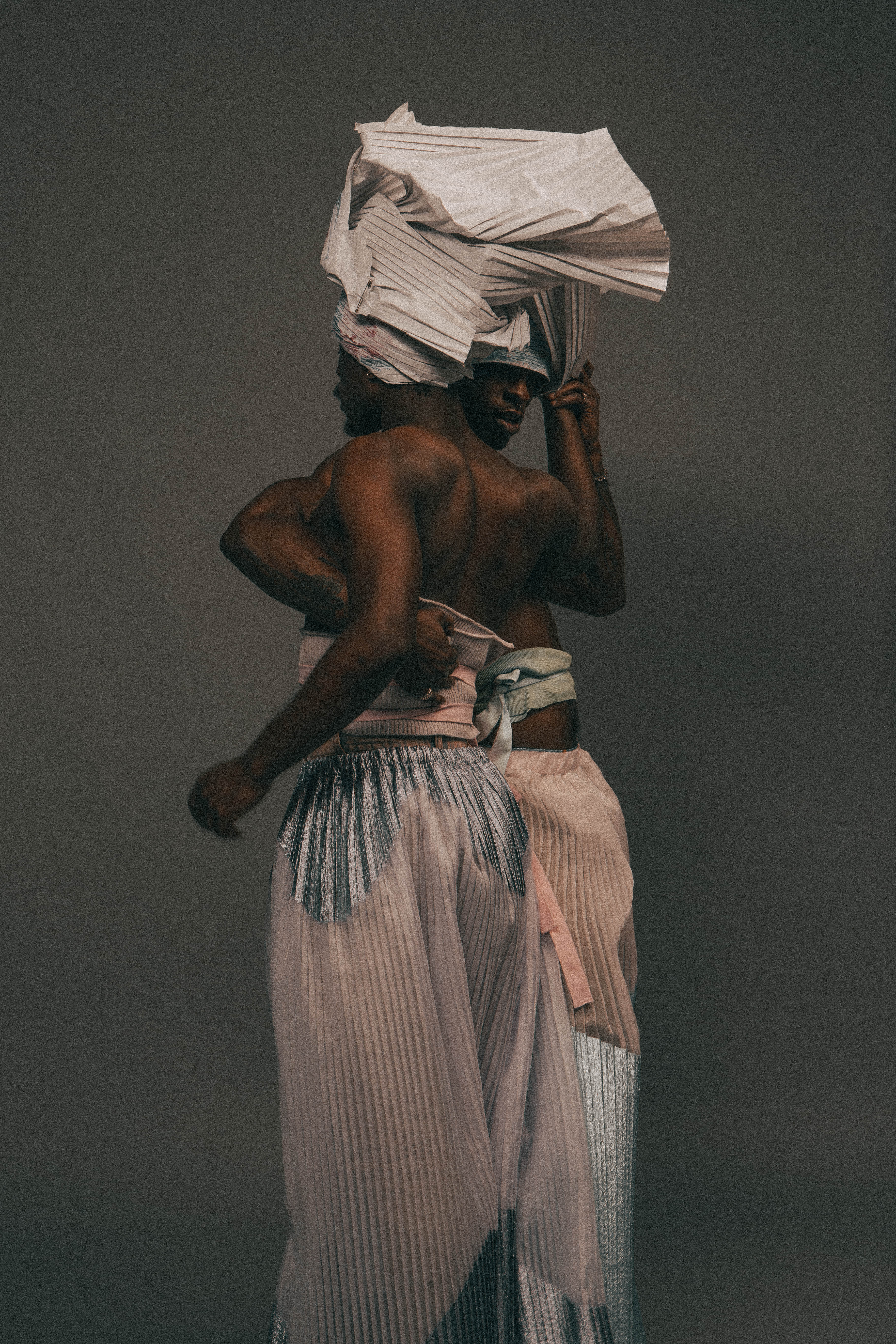

“Not for nothing, a bitch is on whole ass
TV shows [Project Runway and design
work for a Drag Race contestant] and
there's no funding anywhere to help a
bitch, you know, start a business and
actually do something with this. Where
could I be if I had the technology, the
income, the resources, the everything
that I need to make things happen? If
we had reparations? Queer Black people
continuously push the culture forward
and for there to be no give back is wild.
If someone gave me five dollars and
someone gave me five million, I'd be
ready to move in either direction, but
it's always making five dollars look like
five million and I’m just tired of that.”
KHADIJAH: Comparing “fast
fashion” to the clothes that you
put together for our fashion edi-
torial, I see how much time you
put in. When somebody reads the
look—whether they're out in the
street or looking in the pages of
Logic(s) magazine—their capacity
to understand what you're
visually signifying requires gen-
erational time. Reading the look
requires drawing on your own
social context and all of these
institutions that are not deemed
institutions of Black life, whether
it's specifically Black trans wom-
en’s underground queer scenes,
or if it's stuff that's on TV making
it into the mainstream. When I
see your designs, I’m visualizing
the labor, visualizing the textures,
the seams of all these different
relationships, connections—
between each other and across
generations. And I compare that
to the iPhone’s sleek, minimalist
design. Like I don’t know who the
fuck designed this shit. I could
probably look up the patent
but it’s so nonspecific, so stan-
dardized, so uniform. It's so “we
can't even see the seams of it,”
everything is sealed within the
box. And if I open it, I violate the
warranty.
BONES: That's the confined box
that I feel like I've existed in
for my whole career, my whole
existence, that I'm just starting to
peel the paper off. It’s like peeling
wallpaper off of a glass box and
realizing that there's a whole
way of existing that can happen
outside of this facade that's given.
The facade that's built upon
“merit” that holds a whole group
and community of people back.
That’s the “trial and tribulations”
and it’s exactly like what you said:
if you break this box, you’ve bro-
ken the warranty for your security
and you can break the warranty
just by expressing your existence.
If you don't stand true or stay
alert to what the fuck is happen-
ing around you, that wallpaper
becomes concrete. It becomes a
real concrete box that we didn’t
build for ourselves, but we're
just given the ingredients to and
then we're like, “Oh, let's make
these things together because
we innovative.” And then next
thing we know, we in a box, a
concrete ass box. All the tools
that are given to us are always
wrong, always ready to trap us
in a box. It’s crazy because I just
bought an iPhone and I'm pissed
off at Apple because I open up the
fucking box and there's only a wire
in the box. There's no box for the
fucking wire. I'm like, So how am
I supposed to charge the fucking
phone?
KHADIJAH: Let me just plug this
into my mouth real quick—
BONES: Yeah, like, let me just plug
this into my mouth real quick so
I can charge my thousand dollar
phone. I just couldn’t believe it.
KHADIJAH: White people always
love slicing shit up. You see, when
they gentrify shit and then they
sell half a sandwich?
BONES: Right? I literally broke the
box, like, maybe there’s a com-
partment I’m missing. Maybe it’s
hiding somewhere because it has
to be an error. Like, I’m getting
chills over my body because this
is exactly it. We’re buying up their
stuff thinking we’re getting every-
thing we need and then literally
ripping stuff apart because the
most basic thing is missing. After
I done paid twelve hundred two
dollars and forty seven cents for
the fucking phone, you couldn't
give me the box to attach to the
wall, for the wire to make this
thing work? It just blew my mind.
So now that you're saying this, it
blows my mind even more, like
what? What? But that's literally it.
That’s literally Black in tech. We’re
using their stuff and still not being
given the proper resources because
you know that the people who are
usually buying Apple products
are white people who are going to
sit in the store as you set up their
iPhone and buy all the accessories.
That is what it’s built for, it's not
built for everybody. Everybody
can maybe access it but in order to
really use it, you still got to cough
up some more—you still got to
give another limb.
KHADIJAH: The thing is, we're
communicating in different
universes because in my universe,
if I sell you some shit that costs
more than your rent, you will be
able to plug it into the wall.
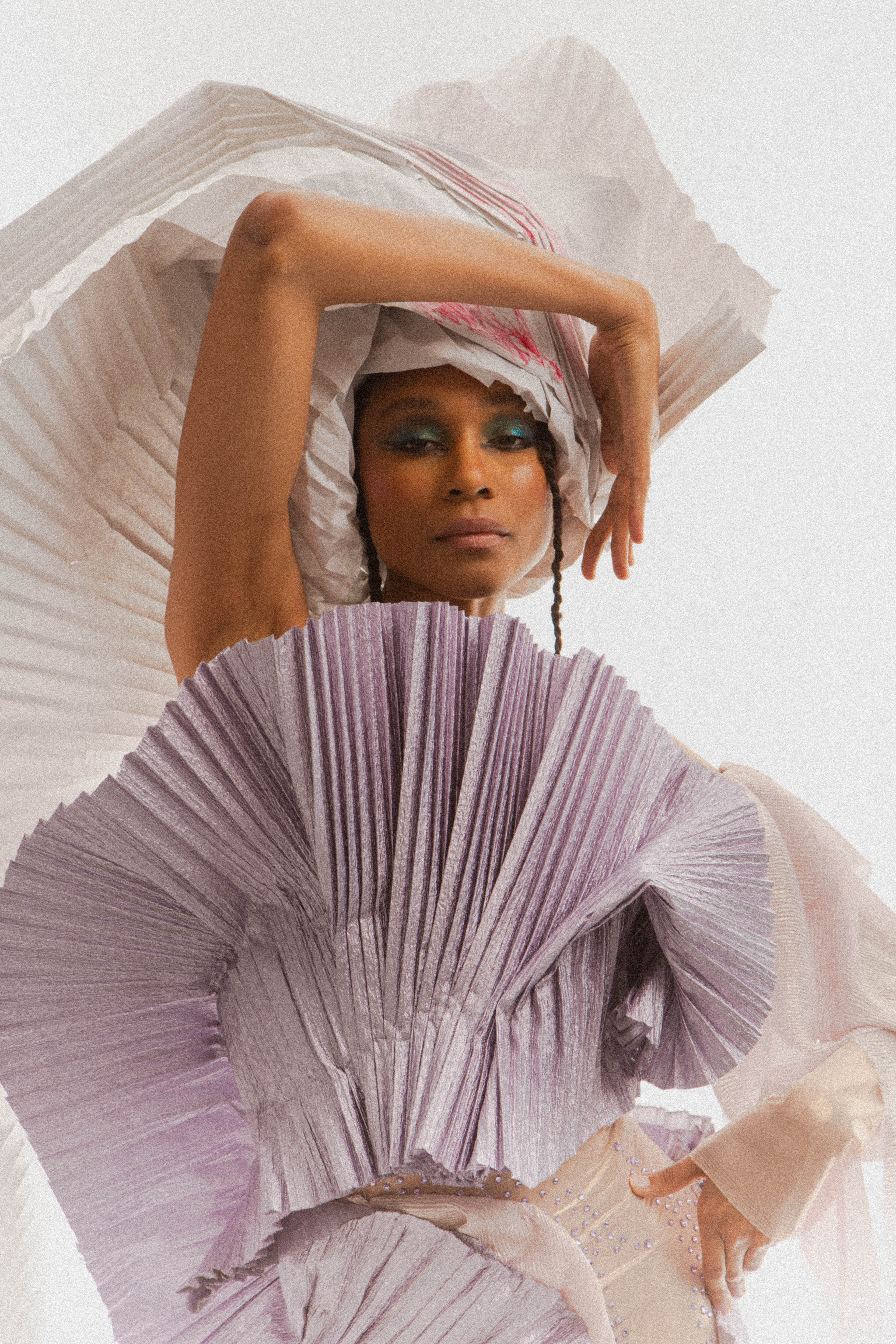
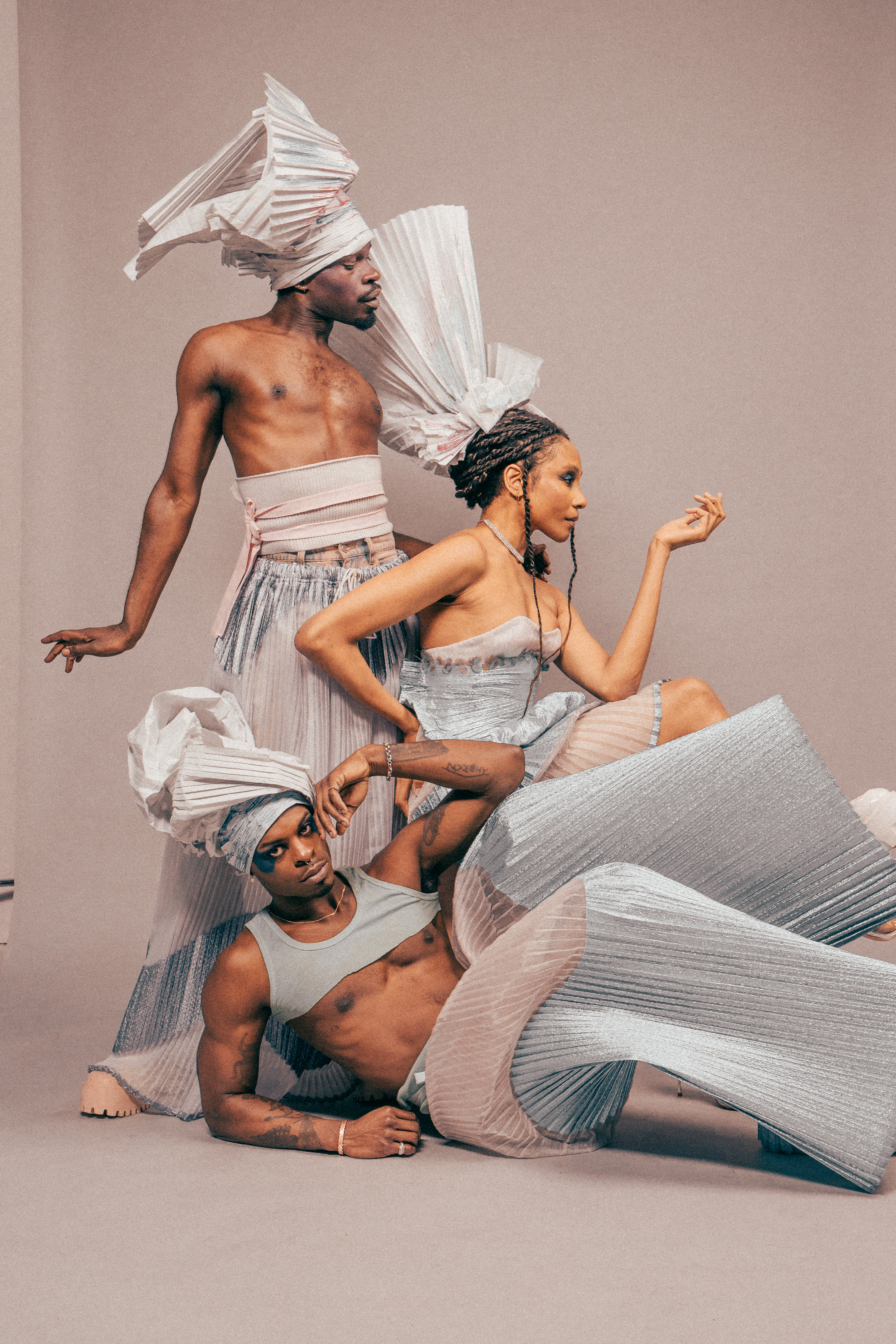
KHADIJAH: Can you walk us
through your “tech stack?” What
materials did you use? What tools
and techniques did you rely on to
design the fashion editorial?
BONES: I sourced most of the
materials from the garment
district but a lot of the accessories
and whatnot came from Rainbow
and I just did them up to make
them look more “editorial.” There
was a couple of things that were
upcycled from thrift shops and
I took apart certain materials to
build other garments, like the
corset under the dress. I hand dyed
a lot of the cotton fabric to give
it a more expensive feel. It took
ten hours over four days because
you literally have to keep turning
water during the thirty minutes
each piece takes. And depending
on how deep I wanted the color,
I had to redo the process. There
were about six pieces that I dyed
in these fifty-gallon barrels using
Rit Dye.
There’s about twenty hours
of hand stitching and a lot of
under-gluing had to happen for
each layer of the pleats. Within the
purple dress alone, there’s about
500 pleats. I spent about twenty
hours hand stitching all the
beading and sequins.
The machinery and whatnot that I
used—there was a lot of grommet-
ing, so there was a grommet and a
hole punch. I used rotary cutters
and a lot of scissors. We use scis-
sors for paper, we also use scissors
for fabric. And I used an antique
1984 Singer sewing machine that
was actually donated to me for
free. I also used a Singer new age
serger that gives the finishing
touches to the ends of the fabrics.
•
KHADIJAH: I know you were
thinking through how The Jetsons
were so white, cis, heteronor-
mative down to Rosie, their
seemingly enslaved robot. Can
you say more about how you were
thinking differently about Black
queer kinship and futurity as you
developed the looks?
BONES: Even when I just look
at these head wraps, I see paper
with marker, like literally Crayola
marker on the paper. And when
I look at this, I just see such
strength and power in such a
demure and coy way. Not that
Black people in this photo look
coy, but there’s just a softness that
exists to this photo that’s still so
“in yo’ face.” There’s structure.
There’s flow. Even the cut up white
beaters and the wraps around
Mel’s waist is nodding to the
wounds that we so proudly show.
We aren’t afraid to be like, “This is
where I come from. This is how I
talk. This is who I am. This is how
I wear my hair. This is how I wear
my pants and whatever the outside
world may deem it as, this is still
my shit that I don’t give up for
anybody.” And I think that’s just
what Black culture says and that’s
what Black family and community
says.
Whenever I think about the Black
union or the Black community, I
think about how Barnum & Bailey
and the circus industries rip apart
elephant families to make them
work, to make them entertain.
I think about the strength and
the power elephants exude while
being put through torture; still
performing and still able to
perform at a high level. And at a
level that you don’t see the pain
that has been caused to make this
visual stimulant stimulating. I
feel all of that in this photo. I feel
something that feels so soft and
so tangible. It’s almost like giving
folks a glimpse of a Black family
portrait.
